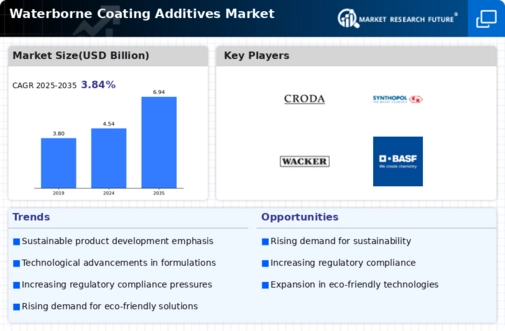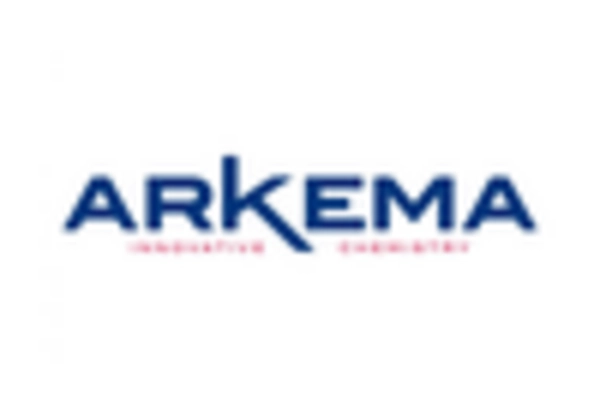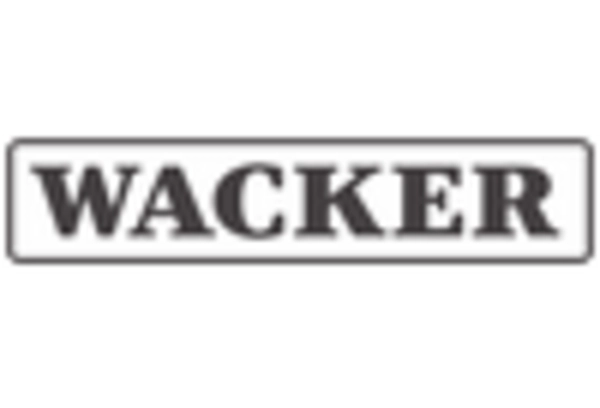Technological Innovations
Technological innovations play a crucial role in shaping the Waterborne Coating Additives Market. Advances in formulation technologies are enabling the development of high-performance waterborne additives that offer superior properties such as enhanced durability, improved adhesion, and better resistance to environmental factors. These innovations are particularly significant in sectors like automotive and industrial coatings, where performance is paramount. The market is witnessing a surge in research and development activities aimed at creating novel additives that meet the evolving needs of end-users. As a result, the market is expected to experience robust growth, with estimates suggesting an increase in market size by over 20% in the next five years, driven by these technological advancements.
Sustainability Regulations
The increasing emphasis on sustainability regulations is a pivotal driver for the Waterborne Coating Additives Market. Governments and regulatory bodies are implementing stringent environmental standards that necessitate the use of eco-friendly materials in coatings. This shift is compelling manufacturers to adopt waterborne additives, which are less harmful to the environment compared to solvent-based alternatives. As a result, the market for waterborne coating additives is projected to grow at a compound annual growth rate (CAGR) of approximately 5% over the next few years. The demand for sustainable products is not merely a trend; it is becoming a fundamental requirement in various sectors, including automotive, construction, and consumer goods, thereby enhancing the market's potential.
Regulatory Compliance and Standards
Regulatory compliance and standards are becoming increasingly stringent, serving as a key driver for the Waterborne Coating Additives Market. Various regions are implementing regulations that limit the use of volatile organic compounds (VOCs) in coatings, pushing manufacturers to transition towards waterborne solutions. Compliance with these regulations not only helps in reducing environmental impact but also enhances product safety for consumers. The market is witnessing a shift as companies invest in waterborne technologies to meet these regulatory requirements. This transition is expected to propel the market forward, with estimates suggesting that adherence to new standards could lead to a market expansion of approximately 15% in the coming years, as industries adapt to the evolving regulatory landscape.
Rising Demand from End-User Industries
The rising demand from end-user industries is a significant driver for the Waterborne Coating Additives Market. Sectors such as automotive, construction, and furniture are increasingly adopting waterborne coatings due to their environmental benefits and superior performance characteristics. For instance, the automotive industry is shifting towards waterborne coatings to comply with stringent environmental regulations and to enhance vehicle aesthetics. This trend is reflected in the projected growth of the automotive coatings segment, which is expected to expand by approximately 6% annually. Furthermore, the construction industry is also embracing waterborne additives for their low VOC emissions and ease of application, thereby contributing to the overall market growth.
Consumer Preference for Eco-Friendly Products
Consumer preference for eco-friendly products is increasingly influencing the Waterborne Coating Additives Market. As awareness of environmental issues grows, consumers are actively seeking products that align with their sustainability values. This shift in consumer behavior is prompting manufacturers to innovate and offer waterborne coatings that are not only effective but also environmentally friendly. The market is responding to this demand, with a notable increase in the introduction of waterborne additives that meet eco-labeling criteria. This trend is expected to drive market growth, with projections indicating that eco-friendly products could account for over 30% of the total coating market by 2026, thereby underscoring the importance of sustainability in product development.

















Leave a Comment